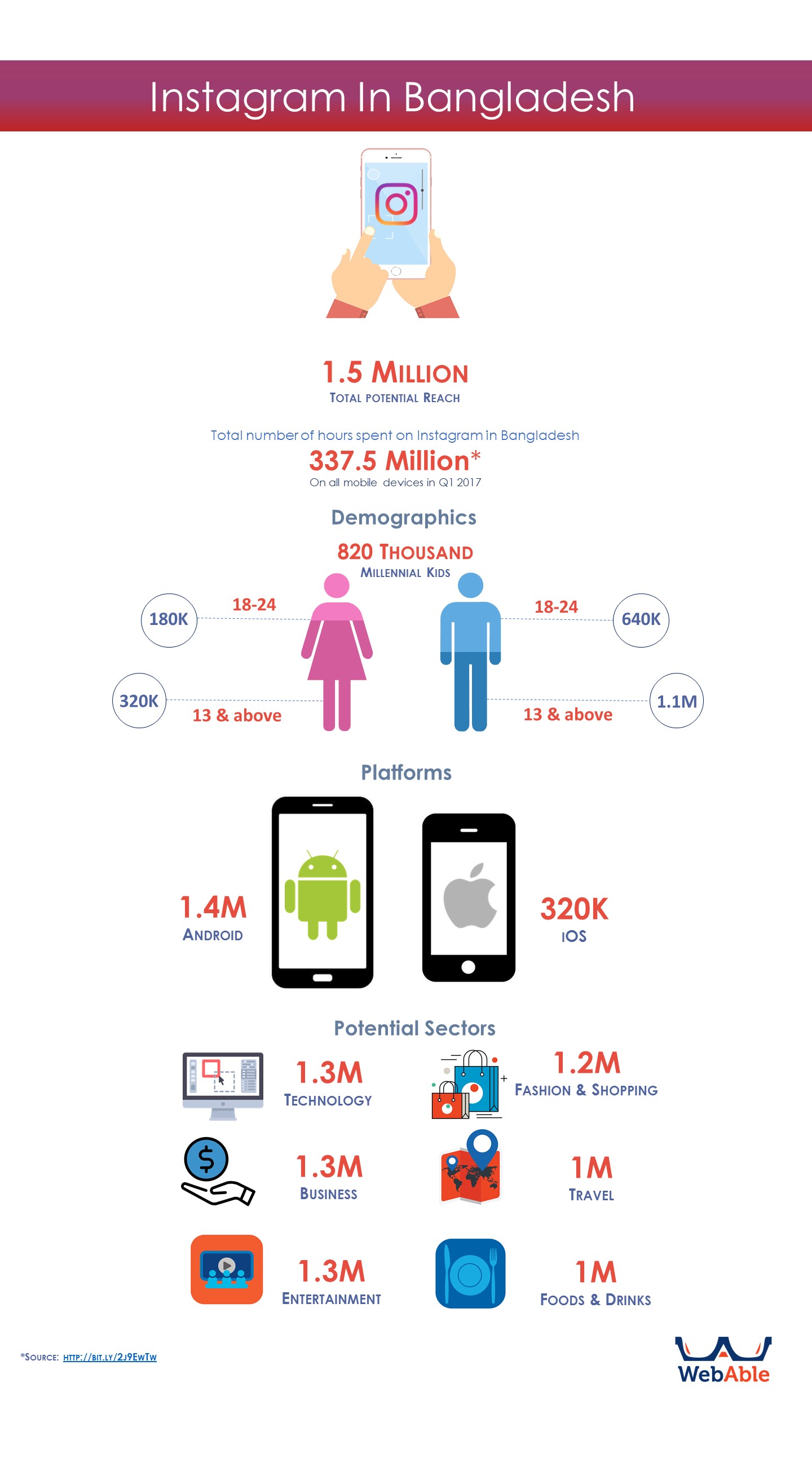Instagram in Bangladesh: A Comprehensive Deep Dive
Facebook Inc.’s photo-sharing app Instagram is fast emerging as a clear number two in Bangladesh’s social media marketing dynamics.
Over 800,000 Instagram users in Bangladesh fall in the 18-24 or ‘millennial’ age category of the 1,500,000 registered users of the application.
For advertisers and brands, the focus now is on bundling, or in agency-speak, ‘FB+Insta’. And Instagram, advertisers say, is set on becoming the number two social media platform in Bangladesh. Facebook’s end goal is that no matter where the user is—on an app or a website, logged in through Facebook or otherwise—he or she should see an ad served by its network.
Facebook’s end goal is that no matter where the user is—on an app or a website, logged in through Facebook or otherwise—he or she should see an ad served by its network.
What could really stop Instagram’s charge is if users abandon the platform and go elsewhere. This is why, upon realizing the potential threat from Snapchat, Instagram has managed to clone and integrate some of its best features.
Mark Zuckerberg, CEO of Facebook, spoke about Instagram’s potential as an advertising powerhouse. It wasn’t surprising one bit. He mentioned, “Instagram is growing quicker on a percentage basis but it’s much smaller. The ad load opportunities are higher on Instagram because Instagram is at a lower ad load than Facebook so there is an opportunity for us to continue to grow ad load on Instagram probably beyond—in a longer time frame than there is on Facebook because of that disparity in terms of where they are today.”
Consider some numbers, Bangladesh has around 1.5 million users (aged over 13) on Instagram which is nearly 5.5% of the top social network’s overall user base (27 million as of April 2017). Dig deeper, and you will see a sweet spot emerging, with over half its Bangladeshi users (800 thousand) falling into the 18-24 or ‘millennial’ age category. Over the last 18 months, it has managed to achieve immense growth, and almost all of it organically. Statistics show the total time spent on Instagram in Bangladesh on mobile devices in hours is 337.5 Million in 2017 (Q1 2017).
Ad bundling
Over the last two years, Facebook has changed the way it pitches Instagram to advertisers.
The focus now is on bundling, or in agency-speak, ‘FB+Insta’. With the option available on Facebook’s advert manager dashboard, advertisers can buy additional reach by paying a little extra. What also works for Instagram is that if the creative on Facebook is of the same size, the ads automatically appear on its platform.
Working with limitations
There’s a growing perception about Instagram being a premium network, presumably owing to its user profile. However, what could really stop Instagram’s charge is if users abandon the platform and go elsewhere. This is why, upon realizing the potential threat from Snapchat, Instagram has managed to clone and integrate some of its best features. As long as it still keeps attracting newer users to the platform, keeps engaging them, it will continue to grow. And advertisers will take notice. The digital pie is still open for everyone to win, according to digital marketing professionals.
What works on Instagram
Needless to say, Facebook, particularly in Bangladesh, has been careful about Instagram’s positioning. This reflects in its pitch to advertisers and brands, where it says that if you want to reach a young, urban, aspirational, high-on-lifestyle audience, Instagram is THE platform to tap.
What is clear is that the older generation prefers platforms like Facebook, while the younger ones are more on Snapchat and Instagram, there is a clear divide there. The older lot don’t want to be on those networks.
Add to that the product itself. The content on Instagram is visual, much in-sync with how millennials, not only in Bangladesh but also globally, communicate: pictures, very little text, emojis, snaps (or stories, if you like). And that has drawn advertisers to the platform—the ability to tell compelling stories about brands, through people (read, influencers). And as a platform, it offers users the best of both worlds (Twitter and Facebook): content discovery, the ability to follow, or for that matter, the social graph. All these platforms (Twitter, Facebook, and Instagram) have their feed-ranking algorithms in place. On Twitter and Facebook, content comes to its users, unlike Instagram, where users look for the content. That’s worked for Instagram.
Importantly, it also fits in with Facebook’s end goal: that no matter where the user is—on an app or a website, logged in through Facebook or otherwise—he or she should see an ad served by its network.
Advertisers and brands are following suit, slowly but surely. By going where the growing, younger audience is. Instagram appeals to certain types of brands. The mandate essentially is something ‘cool’, ‘fun’, which naturally ends up drawing a lot of engagement from users, in terms of likes, comments, or shares. They see Instagram as an important player in the social media marketing mix, which complements Facebook, especially for lifestyle brands around fashion, travel, make-up, etc.
Instagram is a place where people turn their passions into a purchase. With companies from varying industries on the platform, it’s no surprise that 50% of the Instagrammers follow a business. What’s more, 60% of the people say that they learn about a product or service on Instagram and 75% of the Instagrammers take action after being inspired by a post.
What advertisers want from Facebook, today, for Instagram is a smoother interface for better execution. Facebook needs to roll out a smooth enough platform for advertisers and brands, specifically for Instagram. The potential is there. Once they sort that out, it is only a matter of time before it takes off in a big way.
Instagram is like a glossy magazine equivalent to social media. Brands still think of Instagram creatives as print ads: really interesting and attractive.






